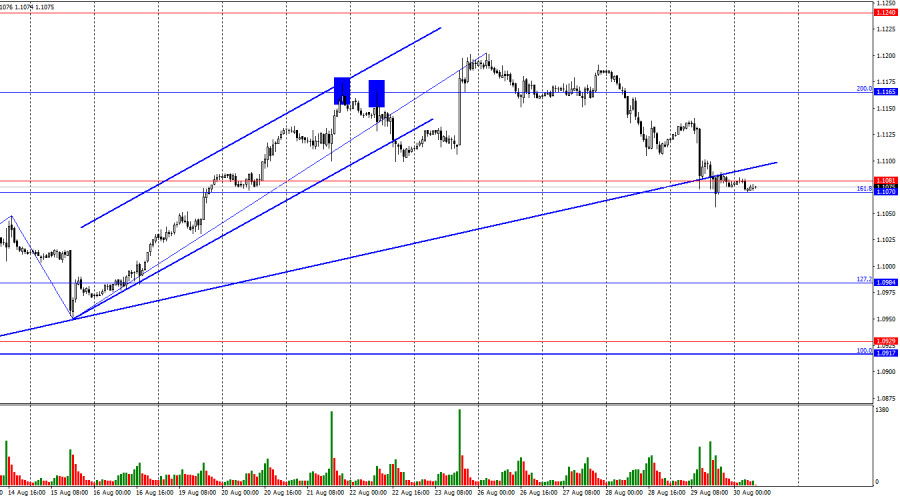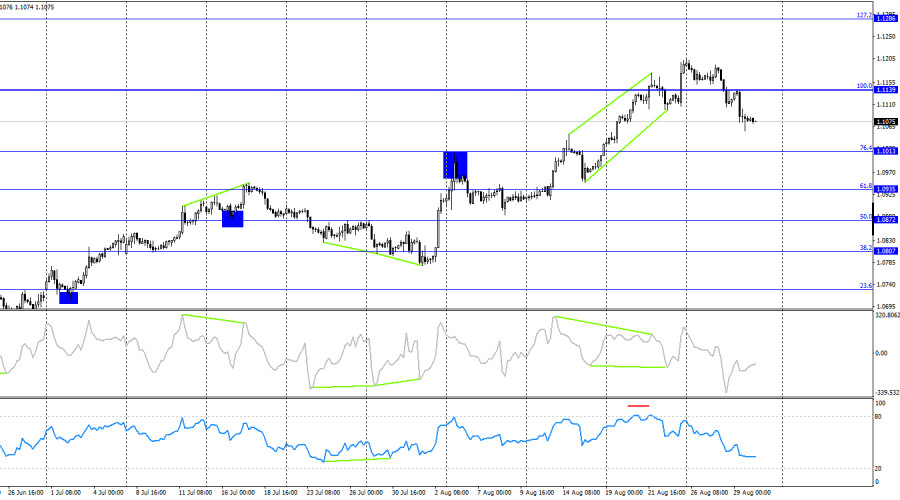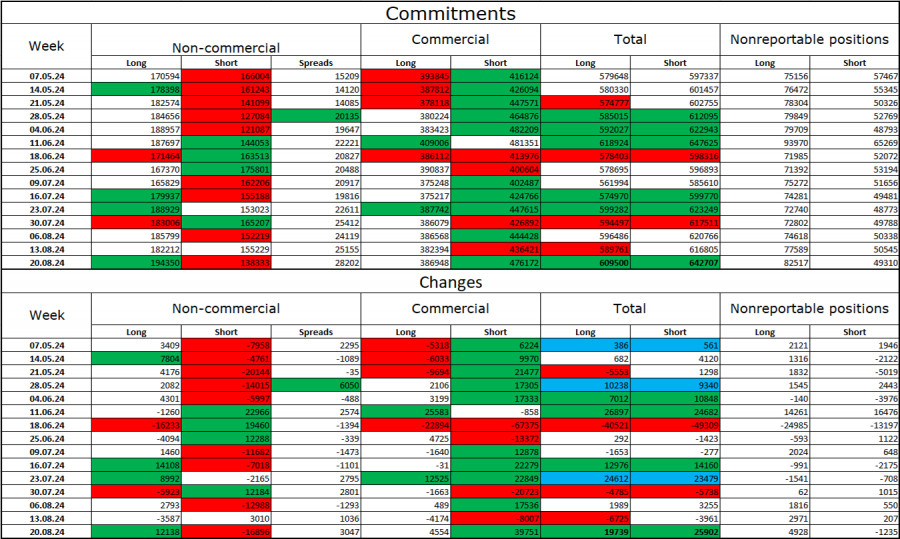
On Thursday, the EUR/USD pair fell to the support zone of 1.1070–1.1081, which I have mentioned several times. A consolidation below this zone will not only allow the euro to decline further towards the 127.2% Fibonacci level at 1.0984 but also indicate the formation of a full-fledged "bearish" trend. A rebound from this zone could lead to a slight rise on Friday.

The wave structure has become a bit more complicated, but overall, it is still clear. The last completed upward wave broke the peak of the previous wave, while the new downward wave has not yet approached the previous low point from August 15. Thus, the "bullish" trend remains intact for now. For the "bullish" trend to be reversed, the bears now need to break the low of the last downward wave, which is around the 1.0950 level. First, they need to close below the trendline.
Thursday's news supported the U.S. dollar. There was a risk that traders would once again ignore the good news for the dollar, but this time they did not. Inflation in Germany in August declined more than expected and fell below the ECB's target. This is a significant factor that could lead to further easing of monetary policy by the European regulator and contribute to the euro's decline. In the second half of the day, the US GDP report for the second quarter was released, showing higher growth compared to the initial estimate. This report also supported the dollar, leading to the decline in quotes. In my opinion, the decline of the euro is entirely logical and should continue. However, today, enough events in the Eurozone and the U.S. could potentially shift trader sentiment back to "bullish." Additionally, the 1.1070–1.1081 zone will provide strong support. The dollar's position is very fragile right now, and any negative report could push the bears out of the market.

On the 4-hour chart, the pair has consolidated below the 100.0% Fibonacci level at 1.1139, which suggests a further decline in the euro towards the 76.4% corrective level at 1.1013. A bearish divergence has formed on the CCI indicator, and the RSI indicator has entered the overbought zone. Thus, there are plenty of factors pointing to a continued decline in the near term. However, can the dollar expect strong growth in the near future? I do not believe so. I recommend tracking changes on the hourly chart for now.
Commitments of Traders (COT) Report:
In the last reporting week, speculators opened 12,138 long positions and closed 16,896 short positions. The sentiment of the Non-commercial group turned bearish several months ago, but bulls have once again taken the lead. The total number of long positions held by speculators now stands at 194,000, while the total for short positions is 138,000.
I believe the situation will continue shifting in favor of the bears. I don't see any long-term reasons to buy the euro, as the ECB has begun easing its monetary policy. In the U.S., rates will remain high at least until September 18. I also want to note that the September rate cut is already fully priced in by the market with a probability of 100%. The potential for the euro's decline looks significant. However, we should not forget about the technical analysis, which at the moment does not provide clear confirmation of a strong euro decline, nor about the news background, which regularly "throws a wrench in the works" for the dollar.
News Calendar for the US and Eurozone:Eurozone – Germany Retail Sales (06:00 UTC)Eurozone – Germany Unemployment Rate (06:00 UTC)Eurozone – Change in the Number of Unemployed in Germany (06:00 UTC)Eurozone – Consumer Price Index (09:00 UTC)Eurozone – Unemployment Rate (09:00 UTC)US – Core PCE Price Index (12:30 UTC)US – Personal Income and Spending (12:30 UTC)US – University of Michigan Consumer Sentiment Index (14:00 UTC)On August 30, the economic calendar is packed with important entries. The news background could have a strong impact on trader sentiment today.
EUR/USD Forecast and Trading Advice:Sales of the pair could be considered after a close below the 1.1165 level on the hourly chart, with a target of 1.1070–1.1081. These trades can now be kept open. Purchases will be possible on a rebound from the 1.1070–1.1081 zone on the hourly chart with a target of 1.1165.
Fibonacci levels are drawn from 1.0917 to 1.0668 on the hourly chart and from 1.1139 to 1.0603 on the 4-hour chart.